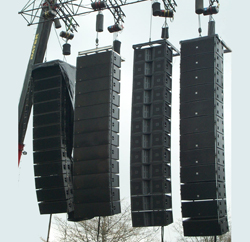
For more normal situations, use the biggest gauges that fit, and the highest quality raw parts, at least hospital or computer grade. If you have the bread, there are some audiophile outlets, which will render even more improvement.
Cabling Secret Weapons: Prior to every event, spray every connection with CAIG Gold (it’s called something else now – Google it and you’ll find the name). Then apply contact enhancer (Tweek or that stuff from Walker audio) to all low-voltage connections.
Electrical Secret Weapon: Get one of those regeneration units from PS audio into your house rack for all your low amperage stuff. This unit will allow you to control the frequency of the regenerated sine wave, which will thicken up the mid-bass and smooth the high frequency. Default frequency recommended is 90 Hz. Some of these regenerators will allow you to specify the voltage – kind of like a Variac – which can come in handy in situations where everyone else has their processing looking at 113 volts and you’re pushing a cool 120 through your regenerator.
Loudspeakers: Best to maintain your own demo kit and not lend it to crazies, which is easier said than done. If you have to borrow your demo loudspeakers from a user/dealer, you are going to have to go through each box and verify driver condition by ear or by TEF.
Using stuff from your dealer who has been doing rodeos in thunderstorms ain’t no way to win a shootout. If it’s a critical shootout, use TEF, and get the best drivers into the most exposed (aurally) boxes – put the ickier drivers into parts of the rig (usually top tier) that won’t be heard as clearly.
If you maintain your own demo loudspeakers, rip those suckers apart and get some silver solder on all the cable terminations. If possible, slip in some low grade audiophile wire – that 10 gauge Monster stuff works great in PA cabinets and isn’t that expensive. When you sell the rig off to one of your dealers, let him know about the tweaks.
Sources: Your options here will vary, as in many situations they will drop you the output of a DJ CD player pushed through someone’s so-so house console. At least everyone else will have the same crummy feed – just make sure that one of your trick XLR cables takes the feed from the console to the input of your loudspeaker management.
And don’t let that cable look too bling – get some dirt on it (use black Mogami raw stock) and fight like a cornered rat to avoid using any other mic cable provided on-site.
If everyone is providing their own source – this is a common situation where each manufacturer gets a 30-minute presentation to impress the natives – don’t overdo things with a tweak CD rig.
Use a lop line laptop feeding a converter through a USB cable. This looks innocuous enough, but if the converter is something like that Sound Devices thing, and you use a high quality USB 2.0 cable, you will have audiophile quality advantages without getting anyone’s nose out of joint.
Your rips, of course, will have to be non-compressed if these advantages are to be audible. And run that laptop on its battery – removing it from the power grid will produce noticeably better sound.
Keep a high quality mic-pre in your rack for mic demonstrations. Most of the time you’ll be stuck with a feed from someone’s console, but occasionally on a playback only situation the client will want to hear a mic at the last minute – you can jam a mic into that thing and get good sound and browning points.
Keep three mics around for these occasions – one old school medium quality dynamic, one new school super common medium quality mic, and one new school top of the line mic. Also, your default should be to run the mic pre in front of your loudspeaker management to warm up the sound a bit, even in playback only situations.
The preamp should be totally visible in your rack – if someone wants it unplugged, fine. Let them come over and tell you to do it. Most likely they won’t.
As our hero pulls his coat aside to expose his weapon, we cut to the bad guy’s fearful eyes, while the track wails with cheesy guitar music and a horrible horn chart, as the network logo fills the screen.
